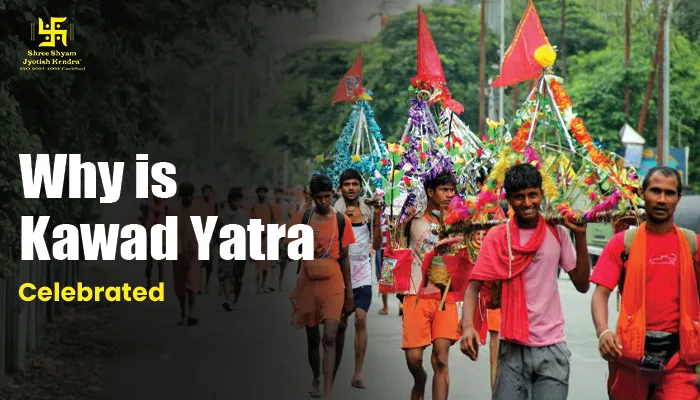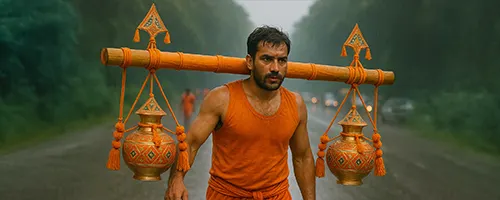 The Kawad Yatra—also spelled Kanwar Yatra—is one of the most sacred and powerful spiritual journeys in Hinduism. Every year, during the holy month of Shravan (Sawan Maas), millions of Lord Shiva devotees known as Kanwariyas embark on this pilgrimage. Carrying sacred Gangajal in beautifully decorated Kanwars, they walk barefoot for miles to offer the holy water to Shivlingas at prominent temples.
The Kawad Yatra—also spelled Kanwar Yatra—is one of the most sacred and powerful spiritual journeys in Hinduism. Every year, during the holy month of Shravan (Sawan Maas), millions of Lord Shiva devotees known as Kanwariyas embark on this pilgrimage. Carrying sacred Gangajal in beautifully decorated Kanwars, they walk barefoot for miles to offer the holy water to Shivlingas at prominent temples.
This spiritual march is not only a test of physical endurance but also a powerful expression of bhakti (devotion), discipline, and humility. With chants of “Bol Bam” filling the air, the Kawad Yatra transforms streets into rivers of orange, as devotees dressed in saffron walk with unwavering faith and pure intentions.
But why is the Kawad Yatra celebrated? What is its deeper spiritual and mythological meaning? In this blog, we explore the origin, rituals, routes, rules, and cosmic significance of the Kawad Yatra—especially in 2025, a year full of rare planetary energies and spiritual opportunities.
What Is Kawad Yatra?
The Kawad Yatra (also spelled Kanwar Yatra or Kavad Yatra) is a sacred Hindu pilgrimage observed during the auspicious month of Shravan (July–August). Devotees, known as Kanwariyas, carry Gangajal (holy water from River Ganga) in ornately decorated containers (kawads) on their shoulders and walk barefoot to their hometowns or nearby Shiva temples to offer it to Lord Shiva.This journey, undertaken with devotion and discipline, symbolizes humility, penance, and surrender. It brings together millions of people from all walks of life who travel from places like Haridwar, Gaumukh, Gangotri, Sultanganj, and more.
The kavad, kanwar, or kānvar (कांवड़) is more than a physical load—it represents the burdens devotees bear to seek divine blessings.
Why Is Kawad Yatra Celebrated?
The Kawad Yatra is celebrated to honor Lord Shiva and to express gratitude for his act of consuming the deadly poison (Halahala) during the Samudra Manthan, saving the universe from destruction. Devotees believe that by carrying the sacred water of the Ganges and offering it to the Shiva Lingam, they are helping soothe the intense heat Lord Shiva absorbed into his body. This act of devotion is seen as both a symbolic and spiritual gesture of bhakti (devotion), self-purification, and karmic cleansing.Celebrated mainly during the holy month of Shravan Maas, which is considered highly auspicious in Hinduism, the Kawad Yatra reflects complete surrender to Shiva. During this time, devotees, known as Kanwariyas, wear saffron-colored clothes, walk barefoot for miles, chant “Bol Bam,” and carry ornately decorated bamboo poles (kanwars) with Gangajal. They avoid indulgences, remain celibate during the Yatra, and often travel in large groups for spiritual bonding.
The Yatra is not just about rituals—it is a spiritual journey that helps devotees overcome ego, face physical hardship, and reflect inward. Many believe that participating in the Yatra brings good health, mental peace, and liberation from sins. It’s also said to fulfill wishes—be it healing a loved one, securing a job, or attaining inner peace. This is why millions of devotees, regardless of social status, caste, or gender, participate in the Yatra every year.
In essence, the Kawad Yatra is celebrated as a festival of faith, penance, and selfless devotion. It brings together spiritual purpose, mythological reverence, and a deep sense of connection to Lord Shiva.
In 2025, this journey holds even more importance as it overlaps with key celestial events and festivals like Sawan Somwar and Sawan Shivratri 2025, making it a spiritually charged time.

Kawad Yatra 2025 Date
The Kawad Yatra 2025 will commence at the beginning of Shravan Maas and culminate on Sawan Shivratri.- Start Date: Friday, July 11, 2025 (First Shravan Somwar: July 14, 2025)
- End Date: Sunday, August 10, 2025 (Sawan Shivratri)
Significance of the Kawad Yatra
The Kawad Yatra is not just a ritualistic journey; it is a profound spiritual experience that symbolizes the devotee’s surrender to Lord Shiva. Every step taken by the Kawariyas (devotees) represents a vow of faith, discipline, and penance. Walking barefoot for miles with the sacred Kawad on their shoulders is believed to dissolve past sins and bring the blessings of Lord Shiva into their lives.The spiritual merit (punya) gained through this pilgrimage is considered extremely powerful. The journey tests the devotee’s physical endurance, mental strength, and spiritual resolve. The Yatra becomes an act of tapasya (austerity), where each hardship faced along the path is seen as a sacrifice made for divine connection and spiritual upliftment.
Moreover, the Kawad Yatra unites people from various walks of life under one cause — devotion. It fosters a deep sense of community, brotherhood, and shared purpose among the yatris. The sight of thousands chanting “Bol Bam” in unison creates a powerful spiritual vibration that energizes both the pilgrims and the environment they pass through.
This Yatra also symbolizes a deeper truth — that true devotion is not about ease and comfort, but about surrender, struggle, and faith in the divine journey, no matter how difficult the path may be.
History of Kanwar Yatra
The mythological foundation of the Kanwar Yatra is deeply tied to the cosmic event of Samudra Manthan, or the churning of the ocean. During this event, both the Devas (gods) and Asuras (demons) churned the cosmic ocean to obtain Amrit (nectar of immortality). But before the Amrit emerged, a deadly poison called Halahala surfaced, which had the power to destroy all creation. None of the celestial beings could contain it, and the responsibility fell upon Lord Shiva, the divine protector of the universe.To save the cosmos, Lord Shiva selflessly consumed the poison and held it in his throat, which turned blue—hence his name Neelkanth. However, the poison generated intense heat in his body. To ease his suffering, the gods and sages poured holy Ganga water over his head. This divine act is believed to be the earliest form of the Kanwar Yatra, symbolizing an offering of gratitude and healing.
Another tale speaks of Ravan, the mighty king of Lanka and a devotee of Lord Shiva. According to the Ramayana and various regional legends, Ravan carried water from the Ganges in a kanwar to offer it to Shiva’s lingam in Baidyanath Dham, Jharkhand. This ancient act of devotion by Ravan also forms the basis of the Yatra’s symbolism and spiritual importance.
In essence, the mythology behind the Kanwar Yatra represents devotion, sacrifice, cosmic balance, and purification. Carrying Gangajal in a Kanwar and walking barefoot to offer it at a Shiva temple is more than a ritual—it is a reenactment of a cosmic story, a way for devotees to connect with the divine and symbolically ease the pain of their beloved Lord.
What Are the Rules of Kanwar Yatra?
- Walk barefoot during the yatra.
- Do not place the Kawad on the ground.
- Stay vegetarian and avoid intoxicants.
- No violence or aggression is permitted.
- Maintain celibacy and spiritual purity.
- Chant “Bol Bam” during the journey.
What Are the Benefits of Kawad Yatra 2025?
Kawad Yatra isn’t just a physical journey—it’s a spiritual detox. The benefits include:- Spiritual Cleansing: It purifies your inner self.
- Fulfillment of Wishes: Devotees believe their prayers are answered.
- Health & Positivity: Walking long distances boosts health and mental clarity.
- Community Bonding: Millions share the same spiritual goal.
Why Is Gangajal So Important in Kawad Yatra?
Gangajal, the sacred water of the Ganges, holds immense spiritual power in Hinduism. It is believed that the Ganga River originated from the matted locks of Lord Shiva, making its water not just pure but divine. During the Kawad Yatra, devotees carry this holy water from the Ganga—especially from places like Haridwar, Gaumukh, or Sultanganj—and offer it to Lord Shiva’s lingam in their hometown temples or pilgrimage centers like Baidyanath Dham and Neelkanth Mahadev.Gangajal is considered a purifier of sins and a medium to gain moksha (liberation). Offering Gangajal to the Shiva Lingam during the month of Shravan is believed to cool Lord Shiva’s anger and grant blessings of health, prosperity, and peace. For Kanwariyas, the act of carrying Gangajal barefoot across long distances becomes an act of tapasya (austerity) and deep devotion.
This symbolic journey of transporting Gangajal reflects the unbreakable bond between Bhakt (devotee) and Bhagwan (God). It’s not just about water—it’s about surrendering ego, walking the path of truth, and expressing one’s purest form of love to the divine.
Why Should Kawad Not Touch the Ground?

In the Kawad Yatra, the kawad (the bamboo pole with water containers) is treated as sacred because it carries the holy Gangajal meant for Lord Shiva. Allowing it to touch the ground is considered a sign of disrespect to the divine energy it represents. Kanwariyas believe that keeping the kawad elevated is a form of devotion and purity, and touching the ground may diminish the sanctity of the offering.
Traditionally, it’s said that the kawad should only rest on specially prepared stands or should be held by a fellow Kanwariya when the bearer takes a break. This practice symbolizes discipline, determination, and reverence, reflecting the devotee’s unwavering commitment to the pilgrimage.
Spiritually, the kawad is seen as an extension of Lord Shiva’s blessings, and treating it with the utmost care ensures that the spiritual merit of the journey is preserved. It also instills a sense of responsibility and mindfulness among the devotees throughout their sacred walk.
Why Does the Kawad Yatra Happen in Shravan Maas?
Shravan Maas, falling in July or August, is considered one of the holiest months for Lord Shiva’s devotees. During this time, spiritual practices like prayers, fasts, and pilgrimages hold deep significance. The Kawad Yatra, performed during Shravan, is one such practice where devotees express their unwavering devotion to Lord Shiva by carrying sacred Gangajal.It is believed that offering Gangajal during Shravan helps devotees earn Shiva’s blessings, especially for inner peace and protection from negative influences. This sacred act is symbolic of the soul’s journey to purify itself by surrendering ego, material attachments, and negativity at the feet of the Divine.
Moreover, Shravan is a time when nature rejuvenates with monsoon rains, mirroring the spiritual rejuvenation experienced by devotees. The Kawad Yatra during this season becomes a physical and emotional act of cleansing, as devotees walk barefoot, chant Shiva’s name, and dedicate their every step to divine service.
Types of Kanwars
There are several types of Kanwars, each reflecting different levels of devotion and physical endurance:- Jhoola Kanwar
- Khadi Kanwar
- Baithi Kanwar
- Dak Kanwar
Popular Destinations for Kawad Yatra 2025
- Haridwar & Rishikesh (Uttarakhand)
- Gaumukh & Gangotri
- Neelkanth Mahadev Temple
- Kashi Vishwanath (Varanasi, UP)
- Baidyanath Dham (Deoghar, Jharkhand)
- Sultanganj (Bihar)
- Augharnath Temple (Meerut) & Pura Mahadev (Baghpat)
Do’s and Don’ts During Kawad Yatra 2025
Do’s- Stay hydrated
- Follow traffic & safety rules
- Chant “Bol Bam” regularly
- Help fellow pilgrims
- Stay calm & focused
- Don’t place the kawad on the ground
- Avoid non-vegetarian food
- No alcohol or smoking
- No aggressive behavior
- Don’t play loud or vulgar music
Things to Carry – Kawad Yatra Essentials
- Sturdy footwear (for support, even if barefoot part of the journey)
- Water bottles
- Medicines & bandages
- Kawad stand
- Towels & clothes
- Energy bars or dry fruits
- Earplugs, torches, mobile charger, and rain gear

Conclusion
The Kawad Yatra is more than just a pilgrimage—it is a spiritual offering, a display of devotion, and a journey of inner cleansing. Rooted deeply in mythology, faith, and the sacred geography of India, the Yatra unites millions of devotees in their love and reverence for Lord Shiva. Whether it’s the symbolic Kanwar that carries Gangajal or the discipline followed throughout the Yatra, every aspect reflects the sacredness of Shravan Maas and the power of belief.As we explored the history, significance, rituals, and destinations of the Kawad Yatra 2025, it becomes evident why it holds such a revered place in Hindu culture. From Haridwar to Baidyanath Dham, and from Gangotri to Neelkanth, every stop is not just a destination but a divine experience that strengthens one’s connection with the supreme. Whether you’re a first-time Kanwariya or a spiritual seeker wanting to know more, this journey is bound to transform your mind and soul.
If you’re planning to undertake the Kawad Yatra 2025 or want to understand its astrological or spiritual relevance in your life, don’t hesitate to connect with Pt. Pawan Kaushik, regarded as the best astrologer in India and a renowned astrologer in Delhi. His divine insights and Vedic wisdom can guide you spiritually, personally, and even professionally.
Get your personalized guidance today from Pt. Pawan Kaushik and align your energy with cosmic forces during this pious season.
 +91 9990176000
+91 9990176000 +91 9999097600
+91 9999097600
 CALENDAR 2025
CALENDAR 2025











